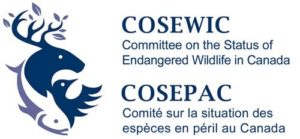The Species at Risk Act (SARA) is a piece of federal legislation in Canada designed to protect wildlife species and their habitats. The goal of the Act is to prevent species from becoming extinct in the wild, to aid in the recovery of species at risk of extinction, and to manage species to prevent them from becoming at risk of extinction. If a species is listed under SARA it gains legal protection in Canada and management plans are developed to facilitate the recovery of the species.
 The Committee on the Status of Endangered Wildlife in Canada (COSEWIC) is a panel composed of scientists, consultants, and academics (both non-government and government experts). An assessment, or status report, on a wildlife species by COSEWIC is the first step towards providing legal protection to a species in Canada. This status report compiles all available information about the species and the specific threats to its survival. It includes a science-based recommendation if the species should be listed under SARA and in what risk category (see below). The Minister of Environment and Climate Change and the federal Cabinet receive the COSEWIC status report and decide whether to list a species under SARA partially based on the report’s recommendations.
The Committee on the Status of Endangered Wildlife in Canada (COSEWIC) is a panel composed of scientists, consultants, and academics (both non-government and government experts). An assessment, or status report, on a wildlife species by COSEWIC is the first step towards providing legal protection to a species in Canada. This status report compiles all available information about the species and the specific threats to its survival. It includes a science-based recommendation if the species should be listed under SARA and in what risk category (see below). The Minister of Environment and Climate Change and the federal Cabinet receive the COSEWIC status report and decide whether to list a species under SARA partially based on the report’s recommendations.
Not every species evaluated by COSEWIC is accepted under the SARA (e.g. the Polar Bear was rejected for inclusion under SARA in 1991, 1999, 2002, 2005, and 2008 despite being recommended by COSEWIC, before finally being listed in 2011), and the risk category recommended by COSEWIC is not always accepted under SARA (e.g. the Eastern Wolf was evaluated by COSEWIC as Threatened but designated by SARA as Special Concern). Further, a wildlife species deemed to have social, economic, or political significance can be denied listing under SARA, thus denied legal protection. A species’ COSEWIC report can also be referred for further consultations or sent back to the scientific community for further study, delaying the possible listing of the species.
Risk categories:
- Not at Risk – a wildlife species that has been evaluated and found to be not at risk of extinction given the current circumstances
- Special Concern – a wildlife species may become a threatened or endangered because of a combination of biological characteristics and identified threats
- Threatened – a wildlife species likely to become endangered if nothing is done to reverse the factors leading to the specie’s extirpation or extinction
- Endangered – a wildlife species facing imminent extirpation or extinction
- Extirpated – a wildlife species that no longer exists in the wild in Canada, but exists elsewhere
- Extinct – a wildlife species no longer exists
Most species at risk are evaluated at the provincial or territorial level in addition to the national level – a species’ status may differ between provincial/territorial jurisdictions and may not be the same in those jurisdictions as the national population.
Risk category of the three focal species of our research nationally and in Atlantic Canada:
| Species | COSEWIC | SARA |
| Canada Warbler | Threatened | Threatened (Schedule 1) |
| Olive-sided Flycatcher | Threatened | Threatened (Schedule 1) |
| Rusty Blackbird | Special Concern | Special Concern (Schedule 1) |
| Species | Nova Scotia | New Brunswick | Newfoundland and Labrador |
| Canada Warbler | Endangered | Threatened | Not listed |
| Olive-sided Flycatcher | Threatened | Threatened | Threatened |
| Rusty Blackbird | Endangered | Special Concern | Vulnerable* |
*equivalent to COSEWIC’s Special Concern
Learn More
Read more about the Species at Risk Act in Canada: Species at Risk Act Public Registry, SAR Frequently Asked Questions, Guide to the Species at Risk Act
